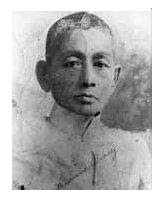Early Filipino revolutionary leaders underwent their baptism of fire during the early stages of the revolution. Forced to act after the discovery of the Katipunan resulting from the ever tightening police surveillance since January 1896. The discovery led to the decimation by arrest and exile of Bonifacio's own Katipunan chapter, Ang Katagalugan, and its sister chapter the Maghiganti in the Diario de Manila printing plant, by late July 1896. High casualty rates and defeats were exacted upon these early leaders and their forces as they fought well armed, well organized and disciplined Spanish forces. Various accounts tell us about the organization (or lack of it) of Filipinos during the the first skirmishes.
"The exposure of key chapters of the Katipunan forced the outbreak of the Revolution in August. His Tondo chapters gone, Bonifacio headed a motley band of Katipuneros in his base in Balara. His troop was to link up in Sta. Mesa at 11 P.M. of Saturday, August 29th, with the column of Ramon Bernardo of Pandacan for a joint assault on the Intramuros at midnight. Bernardo waited in vain in Sta. Mesa. Bonifacio did not keep track of the hour, and marched from San Juan back to Balara. Bernardo's troop was cut to pieces early Sunday morning by a composite enemy force of Guardia Civil Veterana, artillery troops, infantry, cavalry, and carabineros. The noise of battle reached Balara, and Bonifacio rushed to succor Bernardo; in San Juan his column met the same fate as Bernardo's at the hands of the wheeling enemy force." [Onofre Corpuz]
The Katipunan members were organized around Katipunan leaders whose members came from the general population who largely are bereft of any military background (except for members of the colonial units). Lacking weaponry, training, logistical support, the individual soldier was expected to proceed to battle unsupported, drawing their strength from on numbers and surprise to win. As an organization the Katipunan had unwieldy communications, largely ineffective command structure and loose control over organized groups. It truly was a ragtag army whose only strength was their aspiration to free the Philippines from Spanish control.
Under the above mentioned circumstances, it is a truly admirable feat that the early and later leaders of the Katipunan manage to win some battles and bring the first phase of the revolution to a stalemate.
Andres Bonifacio
Andrés Bonifacio y de Castro (November 30, 1863 – May 10, 1897) was a former member of the La Liga Filipina. He was a founder and leader of the Kataastaasan Kagalanggalangang Katipunan ng mga Anak ng Bayan (KKK or Katipunan for short) which advocated Philippine independence by armed struggle. He was known as the "Supremo".
In 1892 he joined La Liga Filipina (The Philippine League), an organization which called for political reforms in the Spanish government of the Philippines. Bonifacio was a Freemason and a member of the Gran Oriente Español (Spanish Grand Lodge). However, La Liga Filipina disbanded after one meeting as Rizal was arrested and deported to the town of Dapitan in Mindanao. Bonifacio, Apolinario Mabini and others revived La Liga Filipina in Rizal’s absence. Bonifacio was active at organizing local chapters in Manila.La Liga Filipina contributed moral and financial support to Filipino reformists in Spain.
On July 7, 1892, the day after Rizal’s deportation was announced, Bonifacio and others founded the Katipunan, or in full, Kataastaasan(g) Kagalanggalang na Katipunan ng mga Anak ng Bayan (“Highest and Most Respected Society of the Sons of the Country”).The secret society sought independence from Spain through armed revolt.It was influenced by Freemasonry through its rituals and organization, and several members aside from Bonifacio were also Freemasons.
From the beginning, Bonifacio was one of the chief Katipunan officers, though he did not become its Supremo (supreme leader) or Presidente Supremo(Supreme President)until 1895. Bonifacio was the third head of the Katipunan after Deodato Arellano and Roman Basa. Prior to this, he served as the society’s comptroller and then its fiscal. The society had its own laws, bureaucratic structure and elective leadership. For each province it involved, the Katipunan Supreme Council coordinated provincial councils in charge of public administration and military affairs and local councils in charge of affairs on the district or barrio level. Bonifacio was a member and eventually head of theKatipunan Supreme Council.
After the early battles in Manila which resulted in defeats but had the effect of tying up Spanish Forces in Manila, Bonfacio, on Gen. Mariano Alvarez's invitation (Magdiwang chief) went to Cavite. The Filipino forces in Cavite under both the Magdiwang and Magdalo factions had early successes and gained control. Events did not turn out in favor of the Supremo as he was subsequently executed on charges of treason after the Tejeros Convention. According to some accounts, this was the culmination of a long running feud between Emilio Aguinaldo and Andres Bonifacio.
General Paciano Rizal, brother of patriot Jose Rizal.
Gen. Lucerio Geronimo (courtesy of Macky Hosalla)
Gen. Artemio Ricarte "Vibora"
General Mariano Alvarez Dr. Pio Valenzuela
The first four brigadier generals of the revolution:
- Aguedo del Rosario
- Vicente Fernandez
- Ramon Bernardo
- Gregorio Coronel














No comments:
Post a Comment